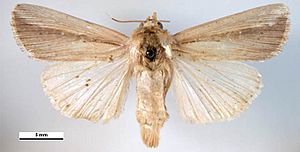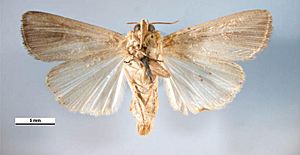False army worm facts for kids
Quick facts for kids False army worm |
|
|---|---|
 |
|
| Dorsal view | |
 |
|
| Ventral view | |
| Scientific classification | |
| Synonyms | |
|
The false army worm, also known as the cosmopolitan moth or nightfeeding rice armyworm, is a type of moth. Its scientific name is Leucania loreyi. This moth belongs to the Noctuidae family. It is found in many parts of the world. You can find it in most African countries, and in warm areas of Asia like India and Sri Lanka. It also lives in the eastern Palearctic realm, the Near East, and the Middle East. This species was first described by Philogène Auguste Joseph Duponchel in 1827.
Contents
What Does the False Army Worm Look Like?
The false army worm is a medium-sized moth. Its wings can spread about 34 to 44 millimeters wide. That's about the length of two small paper clips!
Moth Colors and Patterns
The front wings of the moth are a grayish-yellow color. They have pale lines along the veins, which are like tiny "bones" in the wing. These lines are outlined with brown. There's a short black stripe near the base of the wing. You might also see a small white dot on the wing. This dot helps identify the moth. The outer part of the wing has a row of black dots. Near the tip of the wing, there's a brown patch shaped like a triangle. The back wings are white.
Life Cycle and Habits
The false army worm goes through different stages in its life, just like other moths.
The Larva (Caterpillar)
The larva, which is the caterpillar stage, is reddish-gray. It has yellowish parts between its body segments. It also has a thin, double gray line down its back. Other lines on its body are broken and become clearer towards its rear. The spiracles, which are tiny holes for breathing, are ringed in black.
Adult Moth Activity
Adult false army worms can be seen flying all year round. This means they don't just appear in one season. They have many generations each year. This allows them to reproduce often.
What Do They Eat?
The caterpillars of the false army worm eat many different plants. In Israel, they have been found eating plants like Phragmites australis and Sacharum ravennae. They also eat various types of grasses.
Sometimes, they are found on ornamental bamboo plants. They have also been seen in rice fields. These moths can be pests to winter crops like wheat and barley. They also affect summer crops such as corn, sorghum, and sugar cane. Other plants they eat include Oryza (rice), Paspalum, Saccharum (sugarcane), Triticum (wheat), and Zea (corn) species.

